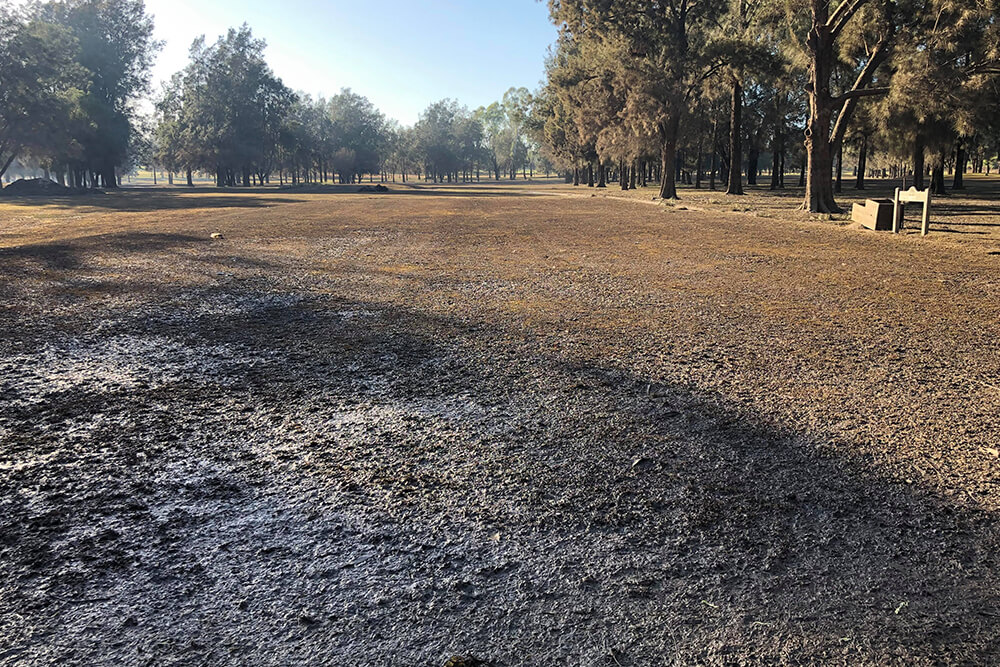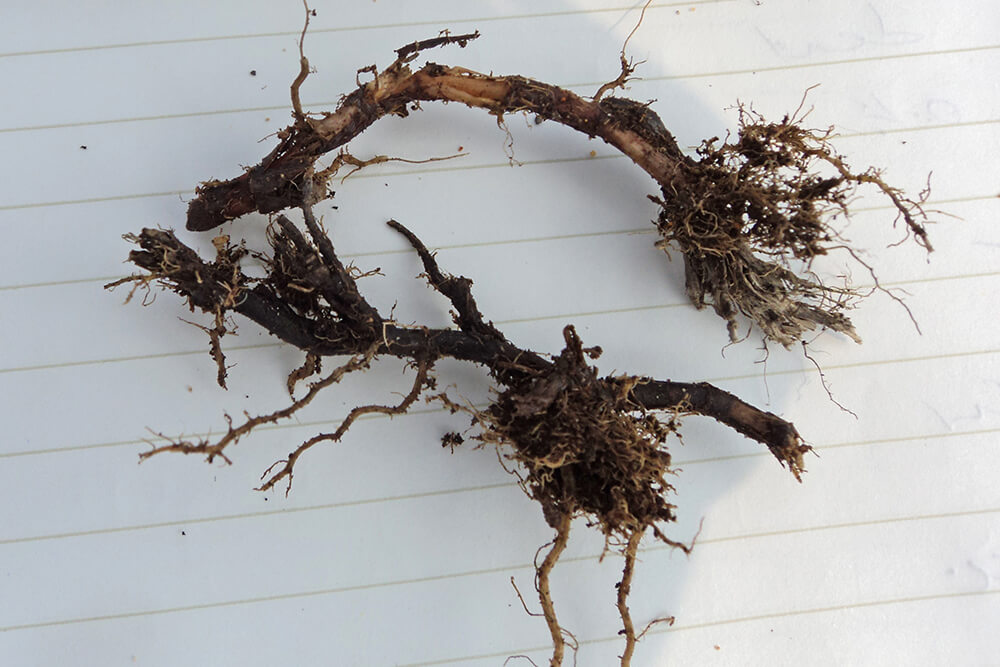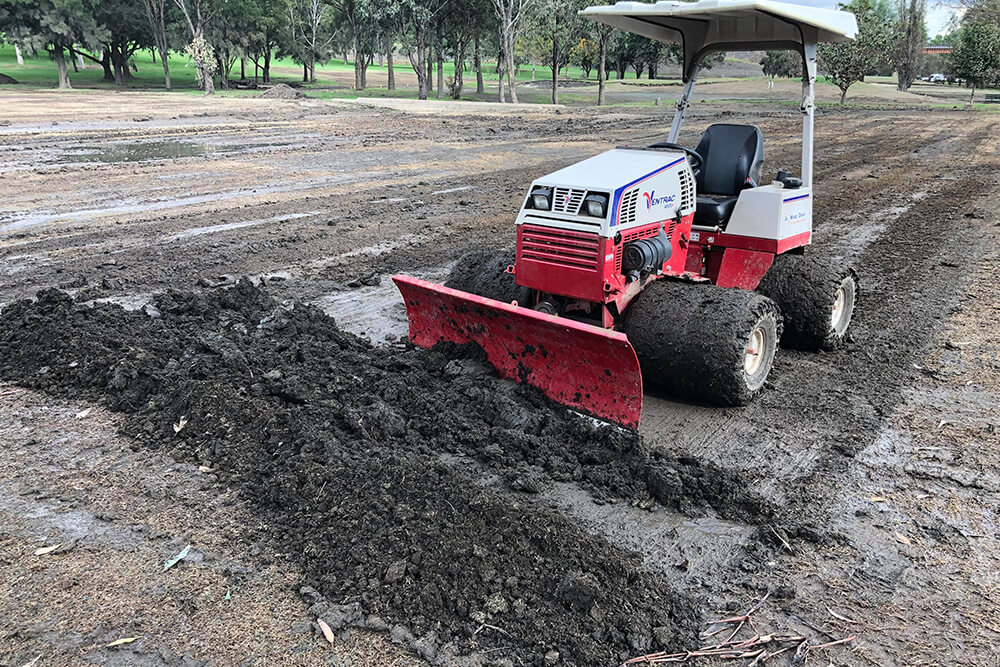In a recent article published in the AGCSA Turf Management Magazine, John Neylan takes an agronomic look at the impact of the recent floods in New South Wales and Southeast Queensland and the short and longterm implications for turf health.
Here's below the transcript of the article, with the AGCSA graceful authorisation.
The recent floods on the Australian Eastern Seaboard brought back memories of the floods in Brisbane in 2011 and in particular the agronomic impacts.
During that time, John was with the AGCSA and along with then Board member Pat Pauli, they visited many golf courses that had been affected by the floods both in Brisbane and further afield. It was an interesting time to observe the effects of inundation and silt deposits on turfgrasses as well as the human element of persistence and resilience of getting turf surfaces playable again.
Later that same year, John also inspected several golf courses in the Bangkok region that had been flooded between October and December. The purpose was to share the Australian experience and, in particular, how to get the playing surfaces back into play.
Given the recent experiences in NSW and southeast Queensland, it was timely to review not only the impacts of inundation on turf but also the effects of the associated weather conditions on turfgrass health and surface preparation.
High rainfall, low light conditions and high humidity are all conditions that appeared to be adversely affecting both cool and warm-season grasses.
Turf and flooding
The effects of flooding are multifaceted with several factors contributing to turf damage and recovery. These include:
- Silt deposits;
- Depth of water;
- Time the turf is inundated;
- Turfgrass species;
- The age of the turf; and
- Surface topography.
Floods are either ‘dirty’ or ‘clean’.
‘Dirty’ floods are associated with silt deposits and considered to be the most damaging. In Australia, silt deposits appear to have had the greatest effects on turf condition, particularly if circumstances restricted the ability to remove it from the turf layer. Wherever there was a lack of clean water or power to pressure clean the silt from the thatch/turf layer of putting surfaces, a silt layer can persist within the profile. This layer of silt has an ongoing effect on restricting water infiltration and root growth.
All flooded greens or sand-based profiles usually require renovation following flooding including hollow coring, scarifying and sanding to break up this layer.
On fairways, the successful removal of the silt depends on the amount of silt deposited and the level of resources available to remove it. Where the silt layers remain on fairways, this continues to impede water infiltration and it takes only a small rainfall event to make the surface muddy and soft. Some form of ongoing cultivation (e.g. slicing, coring or vertidraining) is required to improve soil permeability. In situations where the silt cannot be cleaned off quickly, it tends to bake in the sun, forming a hard layer that increases the amount of turf loss.
In the Thailand experience, damage was mainly as a result of the depth of water and the length of time the turf was under water rather than extensive silt deposits. The Thailand floods provided a good insight into the tolerance of turfgrasses to prolonged flooding, irrespective of the other factors associated with floods. Zoysiagrass (Zoysia sp.) was the worst affected and the Bermudagrass hybrids (Cynodon dactylon x Cynodon transvaalensis) the least affected.
Seashore paspalum (Paspalum vaginatum) is another prominent species used in Thailand and, depending on the depth of the flood waters, was also severely damaged.
Zoysiagrass is a strong, resilient grass that has excellent drought tolerance, it is hardwearing and can be a challenge to mow. The research of Fry (1991) indicated that Zoysia had intermediate tolerance to submersion and would survive 55 days of submersion with minimal damage. In the field, however, Zoysia proved to have little resistance to flooding and most of the Zoysia observed in Thailand was dead with no signs of recovery. The possible key aspect affecting the grass compared to the research data is the depth of the flooding.
In the work of Fry (1991), the turf species were subjected to about 130mm submersion depth compared to at least 1000mm on the flooded golf courses.
Seashore paspalum is a popular grass on golf courses in Thailand because of its striking appearance and the ability to stripe it up like cool-season grass fairways. The references on the tolerance of this species to inundation are a little contradictory and confusing.
Seashore paspalum prefers moist to saturated sites and can withstand brief inundations (including by seawater), however, prolonged flooding is detrimental.
 Depending on the type of flood and how much silt is deposited on the turf surface, there can be ongoing issues with reduced infiltration rates and increased surface moisture due to layers of silt within the profile. Pictured is a fairway at Windsor CC shortly after flood waters had receded.
Depending on the type of flood and how much silt is deposited on the turf surface, there can be ongoing issues with reduced infiltration rates and increased surface moisture due to layers of silt within the profile. Pictured is a fairway at Windsor CC shortly after flood waters had receded.
Other references quoted by Duncan and Carrow (1999) suggest that seashore paspalum is most tolerant of waterlogged conditions on poorly drained sites. There has been a misconception that while seashore paspalum can withstand short periods of inundation, it cannot tolerate longterm flooding. On the flooded golf courses, seashore paspalum was severely damaged depending on the depth of the water. On one particular tee that was under water for eight weeks, but where the water depth was about 300mm, the damage was minimal and complete turf recovery was expected. It is assumed that where there is some light penetration the plant has some improved ability to survive.
Tifdwarf on greens and Tifton 419 on fairways were the least affected by flooding in Thailand and close to complete recovery was achieved. Fry (1991) ranked native Bermudagrass as one of the most submersion-tolerant species and this is consistent with Beard’s (1973) observation that it has excellent submersion tolerance. The field assessments in Australia and Thailand are consistent with these observations and given the damage to the other turfgrass species, it is substantially superior in this respect.
Wherever there was severe turf damage and no recovery, the roots, rhizomes and stolons were rotten and there was no living tissue.
The other interesting aspect of the floods was the effects of the depth of the water and the time the course remained flooded. Where the water was less than 0.5m, irrespective of the time the turf was under water, the turf in many cases (other than Zoysia) was relatively unaffected. As the depth of the water increased, the greater the turf damage, irrespective of the turf type. There was one golf course that was under water for about four weeks though the depth of water was less than 0.5m and consequently, there was very little damage on the Bermudagrass anywhere on the golf course.
It was noticeable on most golf courses that the lower sections of greens and fairways were the worst areas affected.
Most of these lower areas were typically points for surface drainage and were therefore subjected to longer periods of saturated soils. It is also likely that there was some scorching due to increasing water temperatures as the water became very shallow.
The final factor that killed grass on greens, tees and fairways was moisture stress. While there were areas of turf that survived, the root systems were compromised with very few live, healthy roots. Consequently, with the return of warm and dry weather, the turfgrasses would quickly go under moisture stress.
The research on cool-season grasses is very limited and there are no hard numbers describing how many days cool-season grasses can survive under water.
Instead, species have been assigned relative submersion tolerance ratings:
- Creeping bentgrass – excellent;
- Kentucky bluegrass – medium;
- Poa annua and perennial ryegrass – fair.
As with the warm-season grasses, when the submergence depth increases, the potential for injury increases. If the leaf tissue is above the water line, the turf will probably survive. The other factors affecting turf survival are water temperature and light intensity. Beard (1973) also noted that as the temperature of the water increased, the greater the damage to creeping bentgrass.
In John's experience, where the flooding is relatively short-lived and the water and silt is removed quickly, the bentgrass will survive relatively well. However, in discussions around the most recent floods, it would appear that bentgrass will not survive more than 4-5 days under water, the thought being that the damage is primarily due to the lack of oxygen in the rootzone.
 Where flooding is relatively short-lived and water and silt is removed quickly, bentgrass will survive relatively well. However, with the most recent floods, it appears that bentgrass will not survive more than 4-5 days under water.
Where flooding is relatively short-lived and water and silt is removed quickly, bentgrass will survive relatively well. However, with the most recent floods, it appears that bentgrass will not survive more than 4-5 days under water.
Ongoing issues post-flood
Floods obviously create short-term problems, however, after the recovery, there is the longterm health and management of the turf to consider. From previous observations, bermudagrass in greens, tees and fairways will recover even where the turf is under water for several weeks. While the recovery may be very good, the turf, on greens in particular, will exhibit shortening of the root system and an increased incidence of root diseases.
Oxygen depletion, rotting of roots, lack of light and the depletion of carbohydrate reserves are all factors contributing to the deterioration of the root system. Because of the stress that the turf has suffered, it is likely that there will be an increased incidence of disease and reduced wear tolerance during the cooler months.
The root diseases of most concern include pythium and rhizoctonia in creeping bentgrass and ERI fungi in warm-season grasses. All these diseases are most prevalent under wet and humid conditions and where the root system has been damaged. With the warm-season grasses beginning to move into slow growth and dormancy, it is important that they are protected as they go into dormancy and most importantly, during the period of spring green up.

Root diseases, such as pythium, rhizoctonia (cool-season grasses) and ERI fungi (warm-season grasses) are major concerns post-flooding especially under wet and humid conditions and where the root system has been damaged.
The ERI fungi are very difficult to control once an outbreak occurs, however, when it does the following strategy has provided some success:
- Immediately: Apply a tank mix of propiconazole and chlorothalonil. Other fungicides that appear to be effectiveinclude strobilurins (e.g. azoxystrobin) and the sterol inhibitors (e.g. propiconazole and iprodione).
- In 2-3 days: Apply a contact fungicide such as mancozeb and leave it on the leaf to clean up any leaf disease if present.
- In 1-2 weeks: Apply a high potassium fertiliser at 1.5kg/100m2 and manganese at label rates.
- Cease use of growth regulators until disease is under control.
- Make sure that the thatch is kept under control.
- Apply a fungicide such as azoxystrobin as a preventative treatment about six weeks before the disease is likely to appear. Also, apply in late summer/early autumn while there is good growth.
Wherever turf has been flooded there will be ongoing concerns with weed seeds and their germination. It has been noted previously that on some golf courses, there was an influx of weeds very quickly after flood waters had receded. This is due to the turf being thin and less vigorous and weeds being opportunistic plants quickly germinate and invade the spaces.
It would also be expected that over the next 12 months, there will be a progression of germinations depending on the weed type and time of year. Most affected golf courses will need to maintain a regular programme of applying pre-emergent herbicides (to kill the germinating seed) or post-emergent herbicide to kill the established plant.
Depending on the type of flood and how much silt is deposited on the turf surface, there can be ongoing issues with reduced infiltration rates and increased surface moisture due to the layers of silt. Any layers of silt that form need to be broken up and removed to allow water to infiltrate and drain through the profile. Breaking up these layers will improve soil aeration and stimulate the growth of new roots.
Successful flood recovery
The key to a complete and successful recovery is... patience! The turf is going to be weak and forcing growth with nitrogen and lowering cutting heights too early will further weaken the turf and slow the recovery rate.
Some maintenance factors to consider are:
- Coring, verticutting and sanding to stimulate growth and to break up layers;
- Lifting cutting heights;
- Light applications of fertiliser – moderate nitrogen, high potassium and phosphorus (slow release fertiliser);
- Use liquid organics (e.g. seaweed extract)for root health;
- Disease and weed management;
- Check what is in the soil and the condition of the rhizomes/stolons;
- Manage root health and keep checking roots;
- Do not lower cutting heights too soon – during recovery keep cutting heights greater than 6mm;
- Overplanting and plugging bare areas;
- Coring or spiking fairways – keep spiking whenever infiltration rate drops.
- Soil testing – salinity, nutrients and organic matter.
 On fairways, the successful removal of silt depends on the amount deposited and the level of resources that can be deployed to remove it.
On fairways, the successful removal of silt depends on the amount deposited and the level of resources that can be deployed to remove it.
Research
If we accept that we are subjected to a changing climate with more extreme rainfall and damaging flooding events, there is an obvious need to invest in ongoing research into the short and long-term effects of inundation and silt deposits. Golf in particular needs to invest in monitoring the initial damage to turf, the recovery potential and how long the damage will impact on surface preparation.
We hope that the sport, rather than those that manage it, can put its hand up and invest in the future.
REFERENCES
Beard, J. 1973. Turfgrass Science and Culture, pp 297 – 300. Prentice Hall Fry, J. D. 1991. Submersion tolerance of warmseason turfgrasses. Hortscience 26(7):927. 1991.
Carrow, R.N. and R.R. Duncan. 1998. Salt- Affected Turfgrass Sites: Assessment and Management. Ann Arbor Press, Chelsea, MI.

